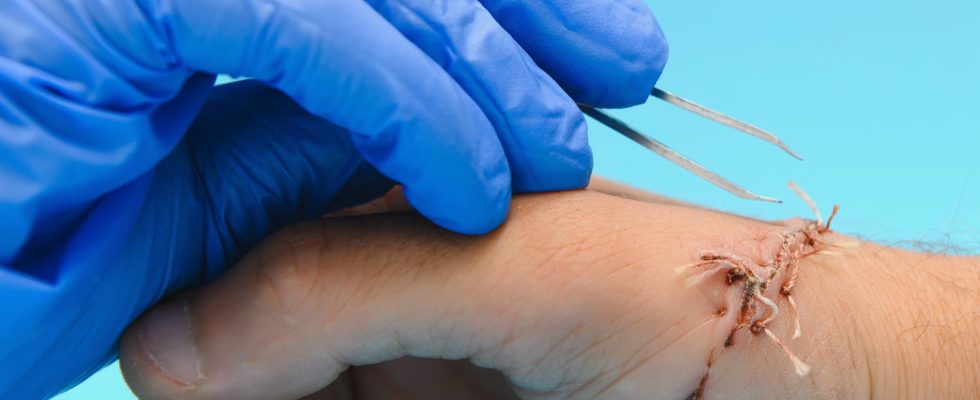The removal of suture threads (non-absorbable) is performed by a healthcare professional. The time depends on the area of the wound and the patient’s ability to heal. Face, scalp, hand… When to remove them? What is the protocol? Is it painful?
When should sutures be removed?
Removal of suture threads occurs after a wound has healed which was repaired with stitches. “This ablation must imperatively be practiced by the medical profession, says Carole, a nurse in a wounds and healing department. There are two main types of suture threads: absorbable sutures and non-absorbable sutures. Only the second category (non-absorbable sutures) will require removal on medical prescription or protocol“.
When to remove facial sutures?
The time it takes to remove the sutures varies depending on the area of the body where the sutures were placed. Below is a general estimate of typical lead times. For the face, “facial sutures can usually be removed within 5 to 7 days after surgeryunless they are absorbable sutures“, says our interlocutor.
When to remove sutures from the scalp?
“Sutures on the scalp are often removed after about 7 to 10 days“she answers.
When to remove sutures from the hand?
“Sutures on the trunk, arms and hands are usually removed between 7 and 14 days after the operation“.
When to remove sutures from the foot?
“Sutures located on the legs and feet usually take longer to heal, and it is common to remove them after 10 to 14 dayseven longer in some cases“.
Suture removal is usually performed by a healthcare professional, such as a physician, surgeon, or trained nurse. “The health professional will remove the threads with asepsis,” continues Carina, a nurse in the same department. The different stages break down as follows:
- Wash the wound with soap and water at neutral PH
- scar wash with an antiseptic
- Removal of threads. “The healthcare professional will use instruments such as sterile scissors or scalpels and suitable forceps”.
- Rinse the scar with saline solution and careful drying of the scar.
Is it painful to remove threads?
In general, the removal of the sutures is not painful. “Sutures are generally designed to be easily and painlessly removed once the wound has healedreplies Carol. However, each person reacts differently and some people may experience slight discomfort or a pulling sensation during the removal process.” However, if you experience excessive pain or tenderness while removing the sutures, it is important immediately notify the healthcare professional performing the procedure”and who can take steps to minimize discomfort, such as using a local anesthetic if needed“. It is also possible that the sutured area is slightly tender after removing the sutures for a few days. “This is usually normal and should gradually improve as healing continues“.
What dressing after removal of stitches?
After the removal of the threads it is recommended to leave the scar exposed. “A simple washing of the scar under the shower with water and neutral PH soap is enough, assures Carina. If the scar is located in a place of the body where there is annoying friction, then we recommend covering it with a bandage for a few days.“. A scarring is random, its shape and color are final after 12 to 18 months. We recommend:
► Appropriate hygiene: Wash the scarred area daily with a neutral pH cleansing gel.
► Essential UV protection: protection factor SPF50
► A self-massage using a moisturizing repair treatment fragrance-free with the agreement of the health professional
Thank you to the team of the wounds and healing department of the Foch hospital in Suresnes (92).
